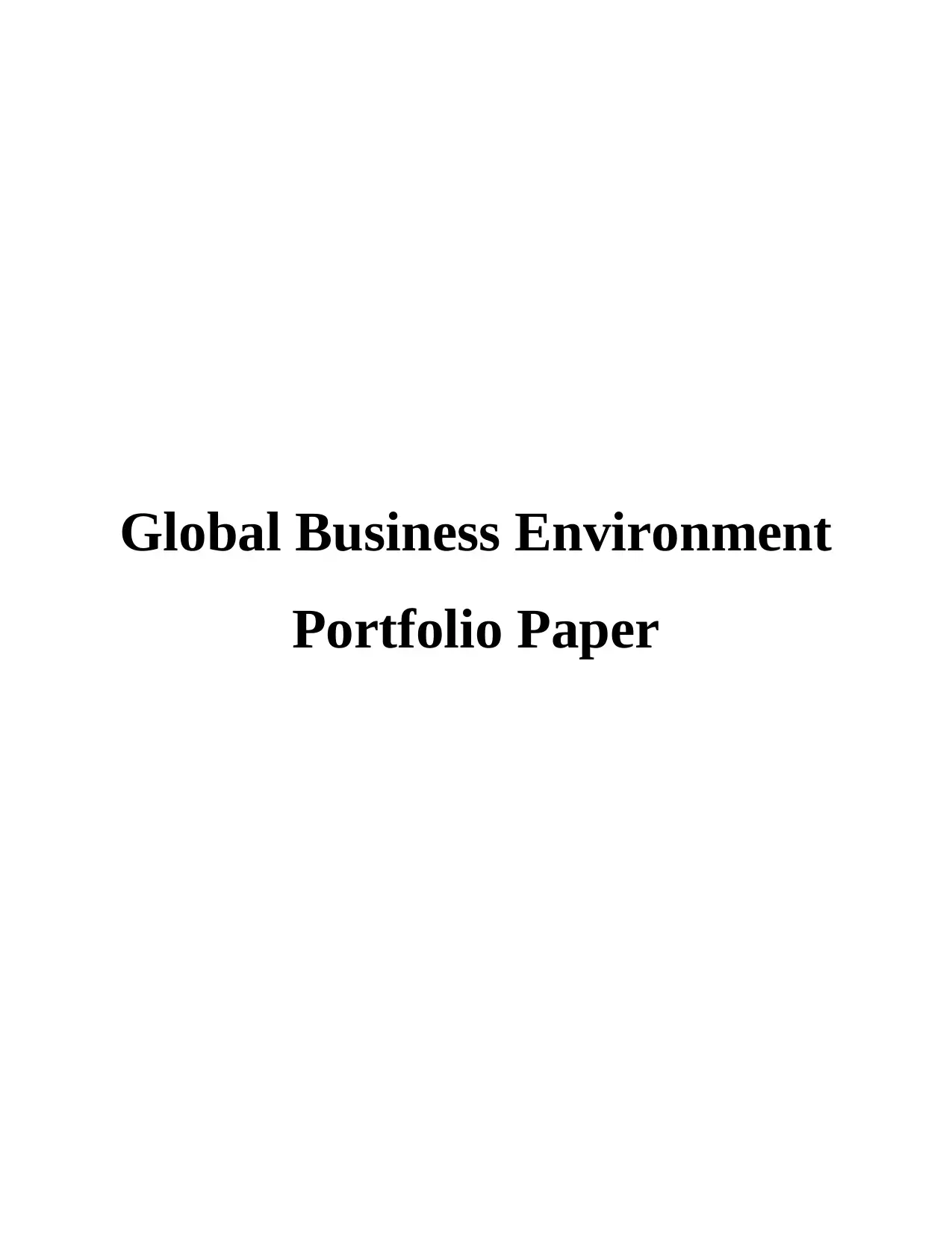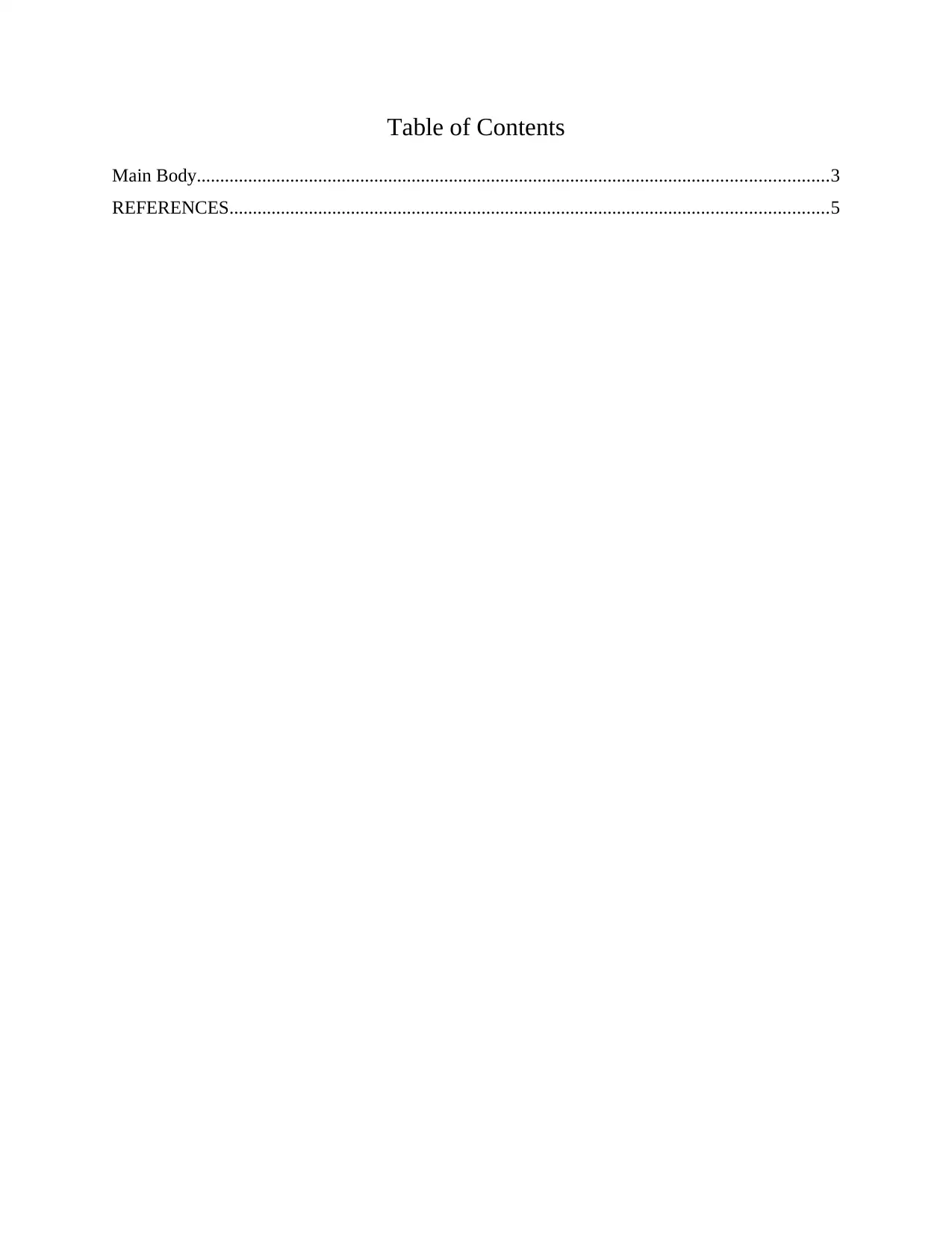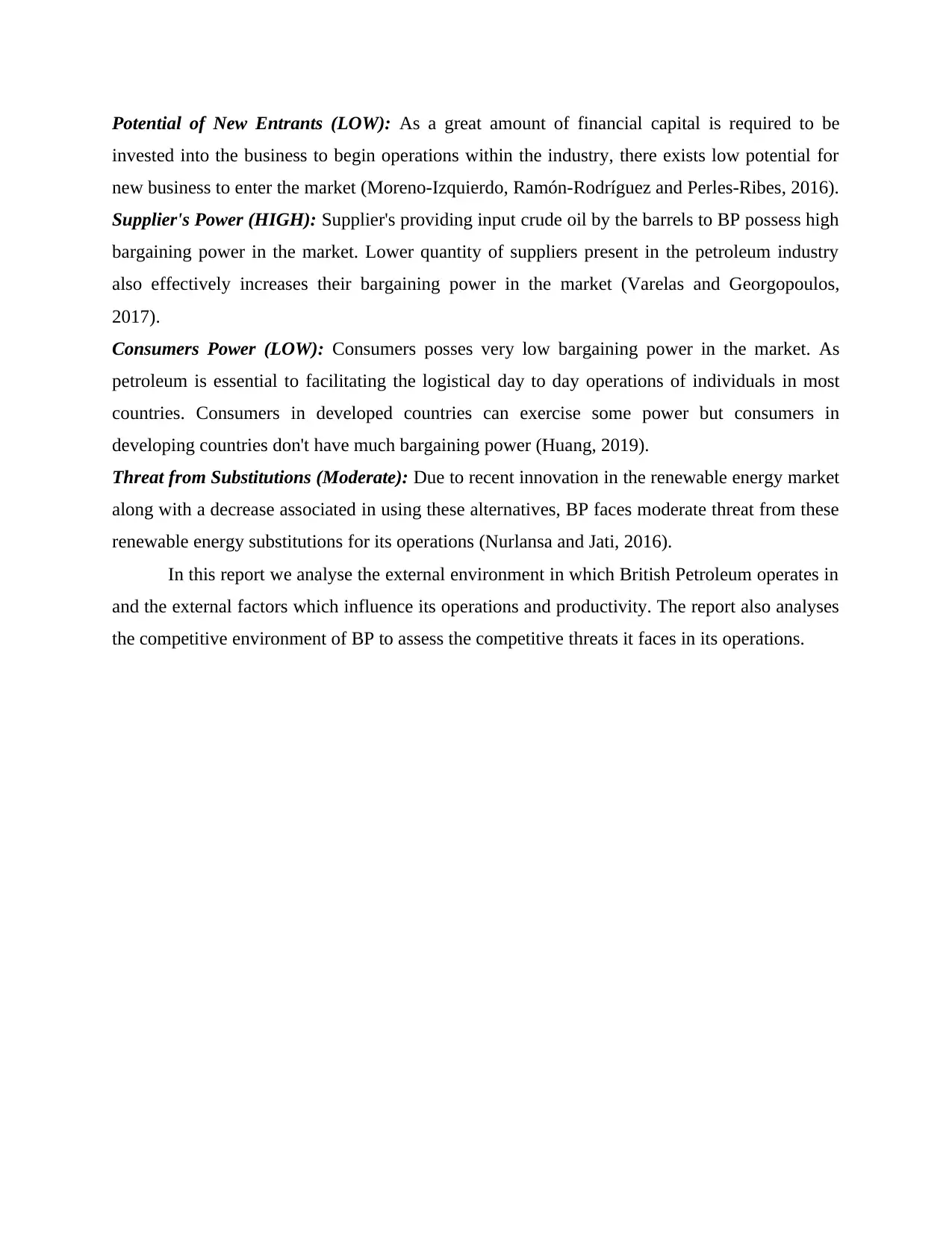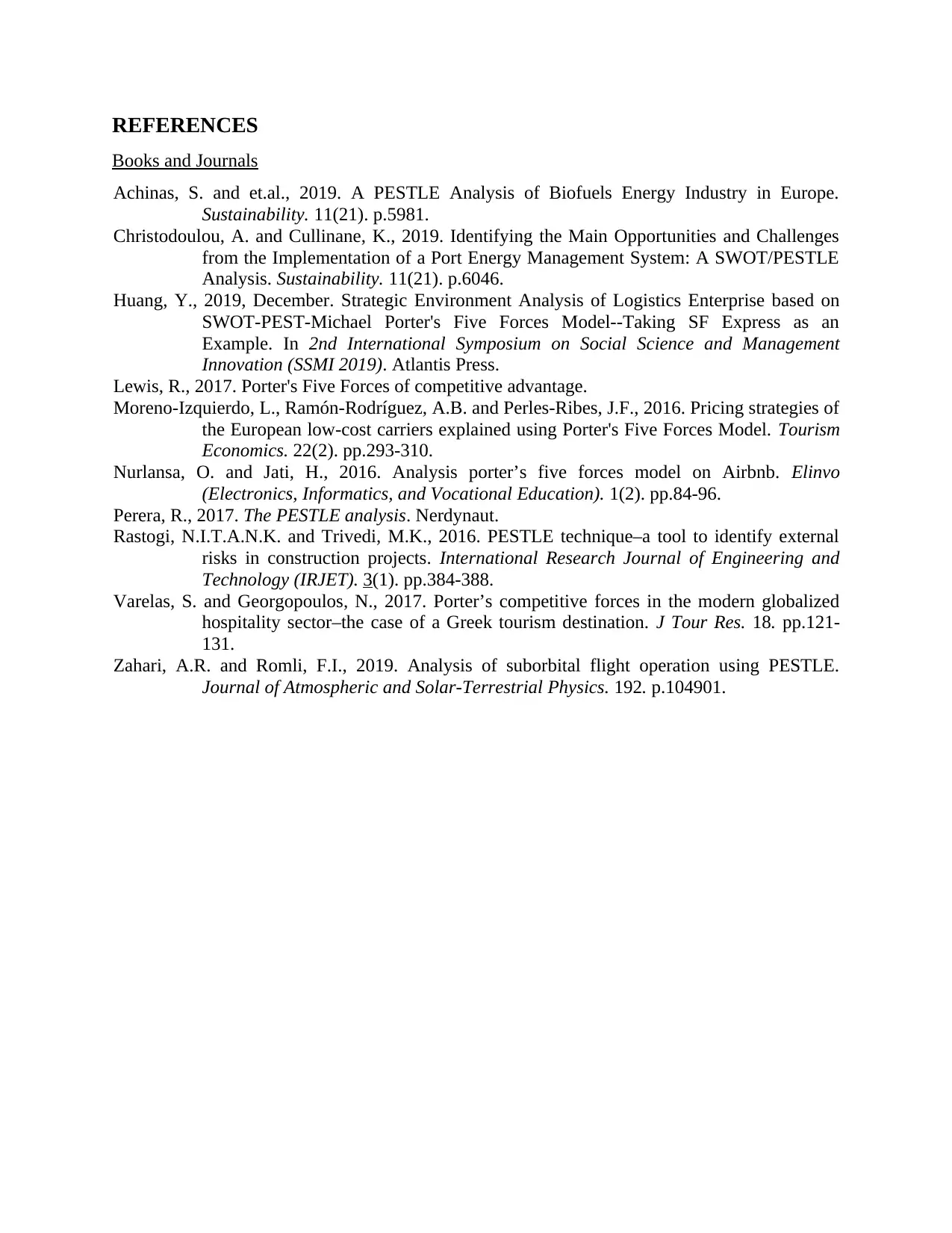BM461: Global Business Environment - BP's Competitive Analysis
VerifiedAdded on 2023/01/12
|5
|959
|33
Report
AI Summary
This report provides an analysis of the external business environment of BP (British Petroleum), examining the various factors that influence its operations and productivity. The analysis utilizes two key frameworks: PESTLE and Porter's Five Forces. The PESTLE analysis evaluates the political, economic, social, technological, environmental, and legal factors impacting BP. The Porter's Five Forces model assesses the competitive landscape, including the intensity of rivalry, the threat of new entrants, the bargaining power of suppliers and consumers, and the threat of substitutes. The report references several academic sources to support its claims and provide a comprehensive overview of BP's business environment and competitive position within the petroleum industry.

Global Business Environment
Portfolio Paper
Portfolio Paper
Paraphrase This Document
Need a fresh take? Get an instant paraphrase of this document with our AI Paraphraser

Table of Contents
Main Body.......................................................................................................................................3
REFERENCES................................................................................................................................5
Main Body.......................................................................................................................................3
REFERENCES................................................................................................................................5

Main Body
The business environment in which companies operate in is convoluted in nature and
forever changing due to multiple internal and external factors. In this report we evaluate the
business environment in which London's BP formerly known as British Petroleum operates in.
Political: The current political instability in the UK due to Brexit poses major challenges to the
international operations of BP with respect to changing international trading laws. Currently
there exists uncertainty on the exact changes that are going to be implemented(Perera, 2017).
Economical: Due to global rise in the cost of input crude oil necessary for the operations of BP,
it can expect an increase in its operational costs refining costs (Achinas and et.al., 2019).
Social: The current social trend to make use of public transportation alternatives instead of
personal vehicles in order to decrease the carbon footprint in environment, effectively hampers
the productivity of BP (Christodoulou and Cullinane, 2019).
Technological: The current technological advancement in the field of auto mobiles through
electric cars running on renewable sources of energy poses major threats to BP's current
operations (Rastogi and Trivedi, 2016).
Environmental: Government can pass laws hindering BP's operations and productivity due to
rise in public concern about the impact of global warming, an issue which results straight
because of the exhausts produced by auto mobiles running on petrol provided by BP
Legal: BP also has to adhere to various legally mandated rules and regulations in order to legally
continue its operations such as Taxation laws, employment laws, safety laws etc and failure to do
so results in legal penalties and fines (Zahari and Romli, 2019).
Porters:
Competition in Industry (High): As BP has to operate in the petroleum market and compete
amongst other industry giants such as Shell, Total, Gulf Coast all of whom want to increase their
own productivity and profitability, the overall competition in the industry is high (Lewis, 2017).
The business environment in which companies operate in is convoluted in nature and
forever changing due to multiple internal and external factors. In this report we evaluate the
business environment in which London's BP formerly known as British Petroleum operates in.
Political: The current political instability in the UK due to Brexit poses major challenges to the
international operations of BP with respect to changing international trading laws. Currently
there exists uncertainty on the exact changes that are going to be implemented(Perera, 2017).
Economical: Due to global rise in the cost of input crude oil necessary for the operations of BP,
it can expect an increase in its operational costs refining costs (Achinas and et.al., 2019).
Social: The current social trend to make use of public transportation alternatives instead of
personal vehicles in order to decrease the carbon footprint in environment, effectively hampers
the productivity of BP (Christodoulou and Cullinane, 2019).
Technological: The current technological advancement in the field of auto mobiles through
electric cars running on renewable sources of energy poses major threats to BP's current
operations (Rastogi and Trivedi, 2016).
Environmental: Government can pass laws hindering BP's operations and productivity due to
rise in public concern about the impact of global warming, an issue which results straight
because of the exhausts produced by auto mobiles running on petrol provided by BP
Legal: BP also has to adhere to various legally mandated rules and regulations in order to legally
continue its operations such as Taxation laws, employment laws, safety laws etc and failure to do
so results in legal penalties and fines (Zahari and Romli, 2019).
Porters:
Competition in Industry (High): As BP has to operate in the petroleum market and compete
amongst other industry giants such as Shell, Total, Gulf Coast all of whom want to increase their
own productivity and profitability, the overall competition in the industry is high (Lewis, 2017).
⊘ This is a preview!⊘
Do you want full access?
Subscribe today to unlock all pages.

Trusted by 1+ million students worldwide

Potential of New Entrants (LOW): As a great amount of financial capital is required to be
invested into the business to begin operations within the industry, there exists low potential for
new business to enter the market (Moreno-Izquierdo, Ramón-Rodríguez and Perles-Ribes, 2016).
Supplier's Power (HIGH): Supplier's providing input crude oil by the barrels to BP possess high
bargaining power in the market. Lower quantity of suppliers present in the petroleum industry
also effectively increases their bargaining power in the market (Varelas and Georgopoulos,
2017).
Consumers Power (LOW): Consumers posses very low bargaining power in the market. As
petroleum is essential to facilitating the logistical day to day operations of individuals in most
countries. Consumers in developed countries can exercise some power but consumers in
developing countries don't have much bargaining power (Huang, 2019).
Threat from Substitutions (Moderate): Due to recent innovation in the renewable energy market
along with a decrease associated in using these alternatives, BP faces moderate threat from these
renewable energy substitutions for its operations (Nurlansa and Jati, 2016).
In this report we analyse the external environment in which British Petroleum operates in
and the external factors which influence its operations and productivity. The report also analyses
the competitive environment of BP to assess the competitive threats it faces in its operations.
invested into the business to begin operations within the industry, there exists low potential for
new business to enter the market (Moreno-Izquierdo, Ramón-Rodríguez and Perles-Ribes, 2016).
Supplier's Power (HIGH): Supplier's providing input crude oil by the barrels to BP possess high
bargaining power in the market. Lower quantity of suppliers present in the petroleum industry
also effectively increases their bargaining power in the market (Varelas and Georgopoulos,
2017).
Consumers Power (LOW): Consumers posses very low bargaining power in the market. As
petroleum is essential to facilitating the logistical day to day operations of individuals in most
countries. Consumers in developed countries can exercise some power but consumers in
developing countries don't have much bargaining power (Huang, 2019).
Threat from Substitutions (Moderate): Due to recent innovation in the renewable energy market
along with a decrease associated in using these alternatives, BP faces moderate threat from these
renewable energy substitutions for its operations (Nurlansa and Jati, 2016).
In this report we analyse the external environment in which British Petroleum operates in
and the external factors which influence its operations and productivity. The report also analyses
the competitive environment of BP to assess the competitive threats it faces in its operations.
Paraphrase This Document
Need a fresh take? Get an instant paraphrase of this document with our AI Paraphraser

REFERENCES
Books and Journals
Achinas, S. and et.al., 2019. A PESTLE Analysis of Biofuels Energy Industry in Europe.
Sustainability. 11(21). p.5981.
Christodoulou, A. and Cullinane, K., 2019. Identifying the Main Opportunities and Challenges
from the Implementation of a Port Energy Management System: A SWOT/PESTLE
Analysis. Sustainability. 11(21). p.6046.
Huang, Y., 2019, December. Strategic Environment Analysis of Logistics Enterprise based on
SWOT-PEST-Michael Porter's Five Forces Model--Taking SF Express as an
Example. In 2nd International Symposium on Social Science and Management
Innovation (SSMI 2019). Atlantis Press.
Lewis, R., 2017. Porter's Five Forces of competitive advantage.
Moreno-Izquierdo, L., Ramón-Rodríguez, A.B. and Perles-Ribes, J.F., 2016. Pricing strategies of
the European low-cost carriers explained using Porter's Five Forces Model. Tourism
Economics. 22(2). pp.293-310.
Nurlansa, O. and Jati, H., 2016. Analysis porter’s five forces model on Airbnb. Elinvo
(Electronics, Informatics, and Vocational Education). 1(2). pp.84-96.
Perera, R., 2017. The PESTLE analysis. Nerdynaut.
Rastogi, N.I.T.A.N.K. and Trivedi, M.K., 2016. PESTLE technique–a tool to identify external
risks in construction projects. International Research Journal of Engineering and
Technology (IRJET). 3(1). pp.384-388.
Varelas, S. and Georgopoulos, N., 2017. Porter’s competitive forces in the modern globalized
hospitality sector–the case of a Greek tourism destination. J Tour Res. 18. pp.121-
131.
Zahari, A.R. and Romli, F.I., 2019. Analysis of suborbital flight operation using PESTLE.
Journal of Atmospheric and Solar-Terrestrial Physics. 192. p.104901.
Books and Journals
Achinas, S. and et.al., 2019. A PESTLE Analysis of Biofuels Energy Industry in Europe.
Sustainability. 11(21). p.5981.
Christodoulou, A. and Cullinane, K., 2019. Identifying the Main Opportunities and Challenges
from the Implementation of a Port Energy Management System: A SWOT/PESTLE
Analysis. Sustainability. 11(21). p.6046.
Huang, Y., 2019, December. Strategic Environment Analysis of Logistics Enterprise based on
SWOT-PEST-Michael Porter's Five Forces Model--Taking SF Express as an
Example. In 2nd International Symposium on Social Science and Management
Innovation (SSMI 2019). Atlantis Press.
Lewis, R., 2017. Porter's Five Forces of competitive advantage.
Moreno-Izquierdo, L., Ramón-Rodríguez, A.B. and Perles-Ribes, J.F., 2016. Pricing strategies of
the European low-cost carriers explained using Porter's Five Forces Model. Tourism
Economics. 22(2). pp.293-310.
Nurlansa, O. and Jati, H., 2016. Analysis porter’s five forces model on Airbnb. Elinvo
(Electronics, Informatics, and Vocational Education). 1(2). pp.84-96.
Perera, R., 2017. The PESTLE analysis. Nerdynaut.
Rastogi, N.I.T.A.N.K. and Trivedi, M.K., 2016. PESTLE technique–a tool to identify external
risks in construction projects. International Research Journal of Engineering and
Technology (IRJET). 3(1). pp.384-388.
Varelas, S. and Georgopoulos, N., 2017. Porter’s competitive forces in the modern globalized
hospitality sector–the case of a Greek tourism destination. J Tour Res. 18. pp.121-
131.
Zahari, A.R. and Romli, F.I., 2019. Analysis of suborbital flight operation using PESTLE.
Journal of Atmospheric and Solar-Terrestrial Physics. 192. p.104901.
1 out of 5
Related Documents
Your All-in-One AI-Powered Toolkit for Academic Success.
+13062052269
info@desklib.com
Available 24*7 on WhatsApp / Email
![[object Object]](/_next/static/media/star-bottom.7253800d.svg)
Unlock your academic potential
Copyright © 2020–2026 A2Z Services. All Rights Reserved. Developed and managed by ZUCOL.





